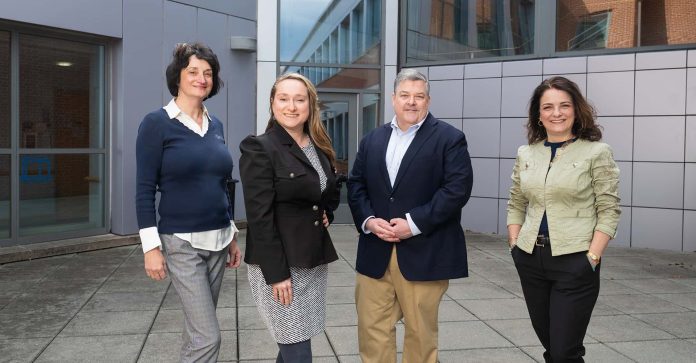Multilingual learners (formerly English language learners) make up 10% of Connecticut’s public school students, and their numbers have increased by more than half since 2014.
They’ve created a great need for bilingual and ESL teachers who are certified in Teaching English to Speakers of Other Languages (TESOL). And the need will only increase as a result of growing immigration, according to Anastasia Sorokina, assistant professor of applied linguistics in Southern’s World Languages and Literatures Department.
“We have this increase in the multilingual learners population, but the state has not been able to keep up in providing teachers who are trained to work with them” she said. “So as a result, we are seeing all of those students who have unique needs, but not enough teachers.”
Southern has long had a graduate program in TESOL but, starting in the fall semester, undergraduates will be able to earn a bachelor’s degree in TESOL, with teaching certification. Sorokina is coordinator.
TESOL “has been declared by the state as a designated statewide shortage area for grades pre-K through 12,” Sorokina said. “This is where we come in, trying to fill this need at the undergraduate level.” It’s the first such program in the state.
“The way it’s built, it has a lot of flexibility,” Sorokina mentioned. “In addition to TESOL certification, the program can be used for bilingual education endorsement in humanities for [grades] five through 12, bilingual education endorsement in STEM five through 12, and even adult education certification. … So there are a lot of possibilities.”
Students will receive support and guidance through every step of the program, including student teaching experience at local schools.
“Connecticut is rapidly diversifying as a state, and … the number of those youngsters who are multilingual learners has increased by about a quarter just over the last few years,” said Christopher Trombly, interim dean of Southern’s College of Education.
“And so at the same time as those numbers of kids have increased, the availability of teachers who were certified to work with such youngsters remains too low,” dean Trombly mentioned. “So, every new year that starts, districts have vacancies for these TESOL teachers.”
Students who choose the BA in TESOL program will also be able to major in another subject that interests them, such as art, psychology, math, English or chemistry.
Sorokina expects an initial class of at least 10 students, with a goal of 20, and already sees a great interest among students. “This program is also transfer friendly, which is great,” she said. “We have a lot of people who want to change their career. We have transfer students. We have students in high schools also speaking multiple languages. We also have part-timers in schools who might be interested in becoming certified, but … it was just a really complicated process. This degree makes it easy, more accessible to a wider population.”
There are almost 150 languages spoken in Connecticut schools — 78 in New Haven alone — but the beauty of TESOL is teachers do not need to be fluent in any language other than English. Sorokina does believe it’s good to have a basic knowledge of a student’s language, however. “When I work with teachers, I always tell them to be able to know the basics, and what I mean by that is just linguistically … being able to compare the languages.”
“We have coursework in linguistics, English grammar, theory of second language acquisition, so they will learn about how languages work,” Sorokina mentioned. “They don’t have to be bilingual. … Even if you’re a monolingual English speaker, you’re welcome, because we’ll teach you about the structure of human language, and you will learn how languages are acquired, so you don’t have to be bilingual yourself.”
Southern’s TESOL program complements Connecticut’s commitment to inclusive education. “We are very hopeful that Connecticut will continue the support it has provided in spirit, financially and educationally,” Sorokina said.
Evelyn Robles-Rivas, director of English language learner programs for the New Haven Public Schools, said there are 40 TESOL teachers in the city, about two per school, but there is room for more.
“Approximately 20% of our population is multilingual learner,” she said. “That includes students that are coming from all over the world.” The largest group is Spanish-speaking, but there are also a large number who speak Pashto, a language of Afghanistan, and Arabic.
“Certification in TESOL is definitely something that is crucial for the success of all students in all the districts in Connecticut,” Robles-Rivas said. That’s because 20 students are needed to create a bilingual class.
“Having an ESL, TESOL teacher in the district is crucial,” she said. “It’s very important not only to serve these students, but also to support mainstream teachers that have these students in their classrooms.”
Elena Schmitt, professor of applied linguistics and coordinator of Southern’s Master’s in Bilingual/Multicultural Education and TESOL, said there are only about 15 undergraduate TESOL programs in the country.
“I think the reason for that is that in the TESOL profession, we support our multilingual learners, but we also support teachers who have expertise in other subjects. To be successful in doing so, it’s really important for our teachers to have understanding of social studies, math, English or other school subjects.”
The bachelor’s program will allow 30 elective credits, allowing for a second major in a school subject. “And if they choose to do so, they can also pass their Practice II exam in the subject area that they have studied and get additional endorsement in the subject area,” Schmitt mentioned.
“I often remind my students that every teacher is a language teacher, because no matter what we teach, we all have to teach language to every student,” Schmitt said.
The program will make it easier to get TESOL teachers into the schools, said Angela Lopez-Velasquez, professor of special education and a TESOL instructor. “The issue in the state is that TESOL cannot be, until now, a stand-alone certificate at the undergraduate level,” she said. So the students have to be … certified already to be able to cross-endorsed.”
The bachelor’s degree will be a plus, “because then our schools don’t have to wait until teachers get a certification in TESOL at the graduate level,” Lopez-Velasquez mentioned. “TESOL and bilingual ed and special ed have been, historically, teacher-shortage areas.”
According to Robles-Rivas, Southern’s new program “will not only help my department, it will not only help New Haven, it will help the entire state of Connecticut. Because right now, if you go to different districts’ websites, there’s always openings for TESOL teachers.”


